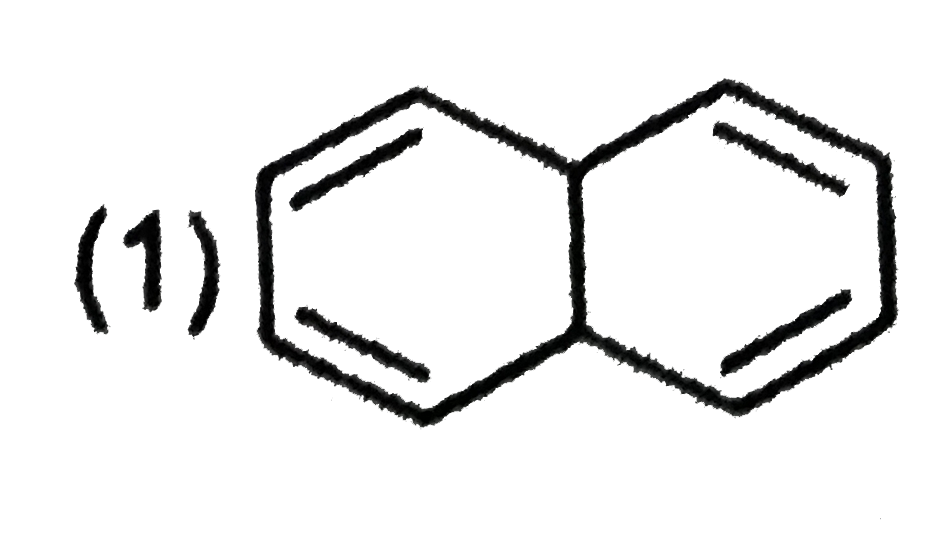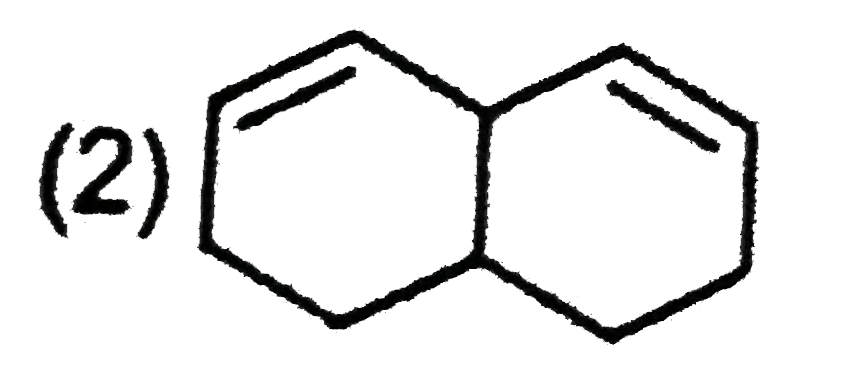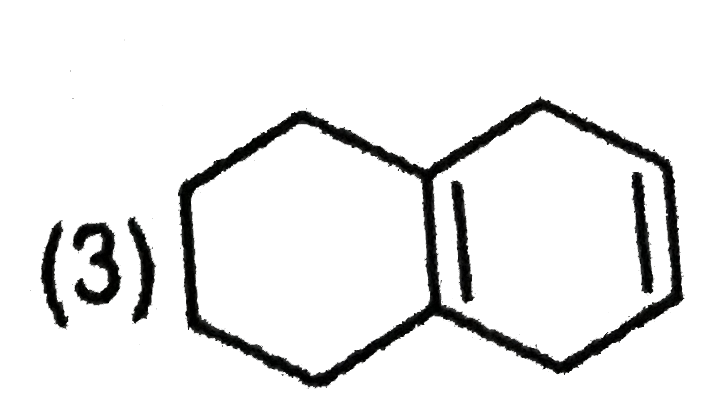An unknown compound decolorizes bromine in carbon tetrachloride, and it undergoes catalytic reduction to give decalin. When treated with warm, conc, potassium permangate, this compound give cis-cyclohexane-1, 2-dicaboxylic acid and oxalic acid. Possible a structure for th unknown compound is-




The correct Answer is:D
To determine the structure of the unknown compound based on the provided information, we will follow a step-by-step approach:
Step 1: Analyze the given information
The unknown compound decolorizes bromine in carbon tetrachloride, indicating that it likely contains a double bond (unsaturated compound). Additionally, it undergoes catalytic reduction to yield decalin, which consists of two fused cyclohexane rings.
Hint: Look for compounds that are unsaturated and can form decalin upon reduction.
Step 2: Understand the reaction with potassium permanganate
When treated with warm, concentrated potassium permanganate (KMnO4), the compound produces cis-cyclohexane-1,2-dicarboxylic acid and oxalic acid. This suggests that the compound has double bonds that can be oxidized to form carboxylic acids.
Hint: KMnO4 is a strong oxidizing agent that can oxidize alkenes to carboxylic acids.
Step 3: Identify potential structures
We need to consider the possible structures of the unknown compound. Since it can decolorize bromine, it must have at least one double bond. The oxidation products indicate that the compound likely has two double bonds that can be oxidized to form the dicarboxylic acid and oxalic acid.
Hint: Look for structures with multiple double bonds that can lead to the formation of the required oxidation products.
Step 4: Evaluate the compounds
We will evaluate each potential compound to see which one meets the criteria:
1. First compound: When oxidized, it forms only oxalic acid and does not yield the required dicarboxylic acid. Thus, it is not the unknown compound.
2. Second compound: Similar to the first, it does not yield the required products upon oxidation. Therefore, it is also not the unknown compound.
3. Third compound: This compound does not yield the required products either, as it does not lead to the formation of the dicarboxylic acid.
4. Fourth compound: Upon oxidation, this compound produces both cis-cyclohexane-1,2-dicarboxylic acid and oxalic acid, meeting the criteria set out in the problem.
Hint: Compare the products of oxidation for each compound to see which one matches the expected results.
Step 5: Conclusion
Based on the analysis, the structure of the unknown compound is the fourth compound, as it is the only one that produces the required oxidation products when treated with KMnO4.
Final Answer: The possible structure for the unknown compound is the fourth compound.
The unknown compound decolorizes bromine in carbon tetrachloride, indicating that it likely contains a double bond (unsaturated compound). Additionally, it undergoes catalytic reduction to yield decalin, which consists of two fused cyclohexane rings.
When treated with warm, concentrated potassium permanganate (KMnO4), the compound produces cis-cyclohexane-1,2-dicarboxylic acid and oxalic acid. This suggests that the compound has double bonds that can be oxidized to form carboxylic acids.
We need to consider the possible structures of the unknown compound. Since it can decolorize bromine, it must have at least one double bond. The oxidation products indicate that the compound likely has two double bonds that can be oxidized to form the dicarboxylic acid and oxalic acid.
We will evaluate each potential compound to see which one meets the criteria:
2. Second compound: Similar to the first, it does not yield the required products upon oxidation. Therefore, it is also not the unknown compound.
Based on the analysis, the structure of the unknown compound is the fourth compound, as it is the only one that produces the required oxidation products when treated with KMnO4.
Topper's Solved these Questions
- REDUCTION, OXIDATION & HYDROLYSIS REACTIONSBook:RESONANCE ENGLISHChapter:REDUCTION, OXIDATION & HYDROLYSIS REACTIONSExercise:Part-II : National Standard Examination in Chemistry
Explore 27 Videos
- REDUCTION, OXIDATION & HYDROLYSIS REACTIONSBook:RESONANCE ENGLISHChapter:REDUCTION, OXIDATION & HYDROLYSIS REACTIONSExercise:Part-III : High Level Problems (Subjective Questions)
Explore 6 Videos
- REDUCTION, OXIDATION & HYDROLYSIS REACTIONSBook:RESONANCE ENGLISHChapter:REDUCTION, OXIDATION & HYDROLYSIS REACTIONSExercise:JEE (MAIN) ONLINE PROBLEMS
Explore 13 Videos
- PERIODIC TABLE & PERIODICITYBook:RESONANCE ENGLISHChapter:PERIODIC TABLE & PERIODICITYExercise:ORGANIC CHEMISTRY(BASIC CONCEPTS)
Explore 27 Videos
- S BLOCK ELEMENTSBook:RESONANCE ENGLISHChapter:S BLOCK ELEMENTSExercise:ORGANIC CHEMISTRY(Biomolecules & Polymer)
Explore 4 Videos
Similar Questions
A compound X react with Na2O2 and forms Y, Y is reacted with nitric acid and then treated with ammonium molybdate to give yellow ppt.
View SolutionAn aromatic compound 'A' (molecular formula C8H8O) gives positive 2, 4-DNP test. It gives a yellow precipitate of compound 'B' on treatment with iodine and sodium hydroxide solution. Compound 'A' does not give Tollen's or Fehling's test. On drastic oxidation with potassium permaganate it forms a carboxylic acid 'C' (molecular formula C7H6O2), which is also formed alongwith the yellow compound in the above reaction. Identify A, B and C and write all the reactions involved.
View Solution
Knowledge Check
A compound decolourises Baeyer's reagent and gives a mixture of propanoic acid and ethanoic acid when treated with a hot and conc. solution of KMnO4 . The compound is
Apent-1-eneBpent-2-eneC2-methylbut-1-eneD2-methylbut-2-ene
An aromatic compound 'A' (molecular formula C8H8O) gives positive 2, 4-DNP test. It gives a yellow precipitate of compound 'B' on treatment with iodine and sodium hydroxide solution. Compound 'A' does not give Tollen's or Fehling's test. On drastic oxidation with potassium permaganate it forms a carboxylic acid 'C' (molecular formula C7H6O2), which is also formed alongwith the yellow compound in the above reaction. Identify A, B and C and write all the reactions involved.
View SolutionAn aromatic compound 'A' (molecular formula C8H8O) gives positive 2, 4-DNP test. It gives a yellow precipitate of compound 'B' on treatment with iodine and sodium hydroxide solution. Compound 'A' does not give Tollen's or Fehling's test. On drastic oxidation with potassium permaganate it forms a carboxylic acid 'C' (molecular formula C7H6O2), which is also formed alongwith the yellow compound in the above reaction. Identify A, B and C and write all the reactions involved.
View SolutionCompound (A) C6H12 gives a positive test with bromine in carbon tetrachloride. Reaction of (A) with alkaline KMnO4 yields only (B) which is the potassium salt of an acid. Write structure formulae and IUPAC name of (A) and (B).
View SolutionAn organic compound contains 69.77% carbon. 11.63% hydrogen and rest oxygen. The molecular mass of the compound is 86. It does not reduce Tollens' reagent but forms an addition compound with sodium hydrogensulfite and gives positive iodoform test. On vigorous oxidation, it gives ethanoic acid and propanoic acid. Write the structure of the compound.
View SolutionAn organic compound contains 69.77% carbon. 11.63% hydrogen and rest oxygen. The molecular mass of the compound is 86. It does not reduce Tollens' reagent but forms an addition compound with sodium hydrogensulfite and gives positive iodoform test. On vigorous oxidation, it gives ethanoic acid and propanoic acid. Write the structure of the compound.
View Solution(a) Give chemical tests to distinguish between compounds in the following pairs of substances ,
(i) Ethanal and Propanal
(ii) Benzoic acid and Ethyl benzoate
(b) An organic compound contains 69.77% carbon , 11.63% hydrogen and rest oxygen . The molecular mass of the compound is 86. It does not reduce Tollen 's reagent but forms an addition compound with sodium hydrogen sulphite and gives positive iodoform test. On vigorous oxidation, it gives ethanoic and propanoic acids . Derive the structure of the compound.
View SolutionAn alkene A on ozonolysis yields acetone and an aldehyde. The aldehyde is easily oxidised to an acid B. When B is treated with bromine in presence of yields a compound C which on hydrolysis gives a hydroxyle acid D. This acid can also be obatined from acetone by the reaction with hydrogen cyanide followed by hydrolysis. Identify the compounds A, B C and D.
View Solution